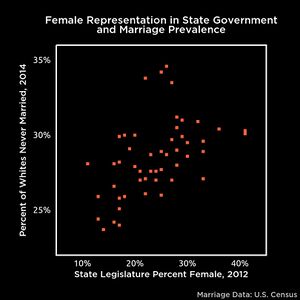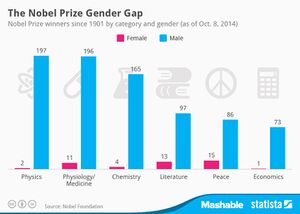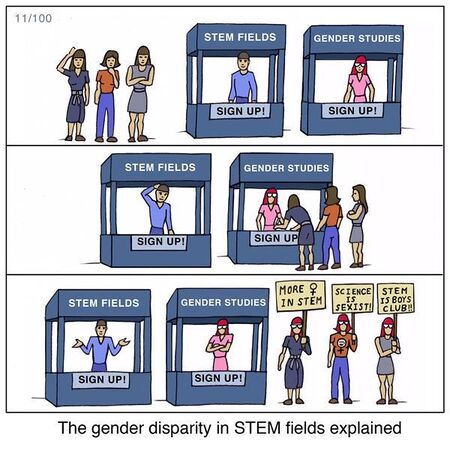Women in STEM
Women in STEM is a meme pushed by certain activists and political entryists with the seemingly arbitrary goal of reaching gender parity. Some argue, ensuing policies have caused lasting damages to various scientific institutions such as deteriorating research standards, academic bias and female monoculture. Some suggested that with their higher agreeableness, women entering the sciences have multiplied bureaucracy and "safe spaces" preventing men from getting things done.[1][2]
Nobel laureate and biochemist Tim Hunt, father of two daughters commented on some issues pertaining to productivity:[3]
Let me tell you about my trouble with girls … three things happen when they are in the lab … You fall in love with them, they fall in love with you and when you criticize them, they cry.
Social engineering[edit | edit source]
There is a reasonably strong desire in feminist, liberal developed countries to bring more women into STEM fields in particular. One tactic has been letting any woman with arms into any low-level tech job, which, of course, causes issues. Other tactics have consisted of campaigns to encourage "girls who code." Proponents include Karlie Kloss, Hillary Clinton, the entire U.S. Democratic Party, various tech boot camps, and various documentaries such as Code Girl Movie.[4]
Choosy maters[edit | edit source]
High earning women in STEM turn into particularly choosy maters and in a sexual free market are generally reluctant to date less educated men unless they earn substantially more (see hypergamy),[5] often turn into bitter singles who end up coping on /r/childfree.
Women as "pioneers in STEM"[edit | edit source]
Feminists hold up female engineers such as Margaret Hamilton, as 'powerful' examples of women being "pioneers".[6] These feminists usually ignore the fact that these women were still only a tiny minority. They also ignore that engineering fields in which women used to be more prevalent, such as computer engineering, were not seen as proper academic work, but subordinate to physics and mathematics,[7] which were male-dominated ever since. Also, early computer engineering had an overlap with data entry, secretary and textile work, which were traditionally female domains.[8]
Many of these women often also received substantial male aid and patronage, or were even posthumously given credit for work they didn't play a large role in by eager feminists, e.g., Ada Lovelace, who is often claimed to be the first computer programmer in history, was likely predated by her confidant Charles Babbage in this accomplishment as he constructed the machine, and there is no actual evidence that she contributed in any substantial way to Babbage's work in this regard.[9] Moreover, she only published minor theoretical works which were never put into practice.[10] What's more, despite being genuinely interested in mathematics, Lovelace apparently could not even solve high-school level algebraic equations, despite working for long periods of time at these sorts of problems.[11] This was also despite Lovelace receiving personal 'tutoring' from such eminent STEM intellectuals such as Babbage himself and the logician Augustus DeMorgan. All of these facts combined seem to indicate that feminist writers are so keen to find historical cases of female STEM geniuses that they will often promote rather unimpressive examples of this throughout the historical record.
Another commonly cited example of a historical female STEM genius is Hollywood actress Hedy Lamarr. Lamarr is often claimed to have invented important aspects of the Wi-Fi technology, when in fact she herself admitted she did only 'creative work on the invention,' while the composer and author, George Antheil, "did the really important part," such that she was even unable to elaborate on the technicalities later on.[12] Rosalind Franklin is frequently claimed to have helped to discover DNA, but she was mocking the idea of helical DNA and was uncooperative.[13] Even the unquestionably most distinguished female scientist in history, Marie Curie-Skłodowska (a 2 time Nobel prize winner), is less eminent in regards to encyclopedia entries and academic citations, than her husband and colleague Pierre Curie, according to the author Charles Murray.[14] In fact, throughout recorded history, women only comprised 1.7% of Murray's sample of historically eminent figures in science according to his selection criteria.
Developing countries[edit | edit source]
The share of females in STEM is higher in developing countries than in developed countries.[15] This is commonly known as the so-called 'gender-equality paradox', where more gender egalitarian countries are often seen to exhibit more substantial sexual dimorphism in several occupational, physiological, and behavioral outcomes compared to less egalitarian countries. For example, Fryer and Levitt (2010) found less of a gender gap in mathematics PISA scores in Middle-Eastern countries than Western countries.[16]
Other studies have also provided further evidence for this, finding that gender gaps in academic performance are greater in more developed nations.[17] Other research has provided further support for the 'gender equality paradox' hypothesis, finding that in two-thirds of countries women have equal performance in high school science, but that far fewer women chose to engage in college-level STEM study than one would expect given their high school science and mathematics performance.[18] The largest gender gaps in terms of female enrollment in college-level STEM subjects are found in the Nordic countries of Finland, Norway and Sweden, which are commonly known for their feminist and progressive governments and culture.[19]
This seemingly paradoxical greater representation of women in STEM in more traditional societies is seen as possibly born from economic necessity, and it may also stem from the parental restriction of women's career choices. Since people in these countries often have more salient immediate survival concerns and a stronger incentive to escape poverty compared to developed countries, it can represent a sound economic investment to induce a talented daughter to enter a potentially high paying STEM career path.
Whereas when women are given more agency to choose their own course of study, many appear to gravitate towards degrees that are likely generally less beneficial to one's future employment prospects, such as 'intersectional feminist studies', or other academic subjects that women may generally have a greater aptitude for, or prefer engaging with, compared to men. Academic affirmative action may also provide further incentives for women to participate in these type of studies.
This evidence essentially implies that women's lack of representation in STEM fields in Western countries is mostly down to their choice of college major, with women tending to avoid STEM subjects. It is also possible that feminism (if one strictly defines this as the legal and social equality of women to men) serves to decrease the number of women in STEM.
The failure of affirmative action[edit | edit source]

Even though Western countries have invested billions of dollars in furthering female education, women's intellectual output relative to men's does not seem to have increased to meaningful extent. Progress is largely made by a tiny group of individuals, nearly entirely consisting of men (as it was always the case). Notably, gender-progressive countries do not have a relative greater level of female achievement than less gender-progressive ones.[20]
Affirmative action is moreover naturally exploited by psychopaths, entryists, conmen and nepotists seeking to extend their range of influence and power. For example, it lead to perhaps the greatest fraud in the history of the Silicon Valley tech bomb.[21][22] There are also countless of examples of female token CEOs running their business into the ground,[23][24][25] and female CEOs are 45% more likely to be fired,[26] with such career women also frequently being miserable.[27] Affirmative action also likely decreases the net performance of such institutions as female professors often benefit from affirmative action policies in socially progressive countries despite lower performance compared to their male counterparts.[28] Women commit about as often scientific fraud as men,[29][30] however that may be attributable to them having less agency over research decisions.
In the early 20th century, Otto Weininger predicted an all encompassing "women's movement" would drag too many women into the sciences and arts who have not much real capability or interest in these male spaces. He further noted only a tiny minority of masculine, 'sexually inverted' (lesbian or transsexual) women could approach genius and male interest in ideas. Instead of what he argued was the typical feminine state of merely embodying sexuality and being chiefly concerned with satisfying their lust or the rearing of children. Edward Dutton suggested only highly religious women are suitable for the sciences.[1]
Even though sex differences in IQ are small (and close to zero regarding general intelligence),[31] the slightly higher mean and (more so) greater higher male variability means that men are going to be somewhat over-represented among intellectual high-achievers, even under fair conditions and disregarding men's higher disagreeableness and status drive which also help. Due to the large overlap, though, this means many women are at least cognitively suitable for many "menial" academic tasks.
Memes[edit | edit source]
References[edit | edit source]
- ↑ 1.0 1.1 https://www.bitchute.com/video/H0TvDqsqjRU/ Episode 42: Do Female Academics Reduce Per Capita Male Genius? - Dr Edward Dutton: The Jolly Heretic
- ↑ https://incels.wiki/w/Creep_(book_chapter)
- ↑ https://www.theguardian.com/uk-news/2015/jun/10/nobel-scientist-tim-hunt-female-scientists-cause-trouble-for-men-in-labs
- ↑ https://www.codegirlmovie.com/
- ↑ https://www.edge.org/response-detail/26747
- ↑ https://fstdt.com/QBYG.YC9QZF8J#comments
- ↑ http://www.bu.edu/eng/about/dean-lutchen/engineering-is-not-science/
- ↑ https://incels.wiki/w/Scientific_Blackpill_(Supplemental)#There_is_no_significant_gender_disparity_in_STEM_graduates_by_sex_in_the_U.S
- ↑ http://robroy.dyndns.info/collier/ch3.html
- ↑ https://www.youtube.com/watch?v=j9Yn3i-DMKw&feature=youtu.be&t=9m19s
- ↑ Stein, D. (1985). Ada, a life and a legacy. MIT Press, p. 90.
- ↑ https://old.reddit.com/r/MensRights/comments/8kig2k/did_hedy_lamarr_invent_spread/
- ↑ https://web.archive.org/web/20160314212535/http://boysmeneducation.com/the-truth-of-rosalind-franklin-and-photograph-51/
- ↑ Murray, C. 2003. Human Accomplishment: The Pursuit of Excellence in the Arts and Sciences, 800 B.C. to 1950. pp 126.
- ↑ https://www.theatlantic.com/science/archive/2018/02/the-more-gender-equality-the-fewer-women-in-stem/553592/
- ↑ https://www.aeaweb.org/articles?id=10.1257/app.2.2.210
- ↑ https://www.sciencedirect.com/science/article/abs/pii/S0160289620300313
- ↑ https://journals.sagepub.com/doi/10.1177/0956797617741719
- ↑ https://journals.sagepub.com/doi/10.1177/0956797619892892?icid=int.sj-abstract.similar-articles.2
- ↑ "Sex differences in PISA: Some counterintuitive results." Speaker: Gerhard Meisenberg http://healthdocbox.com/Psychology_and_Psychiatry/72815349-London-conference-on-intelligence-2016.html
- ↑ https://www.youtube.com/watch?v=5tpsoWx7xmY
- ↑ https://www.youtube.com/watch?v=3CccfnRpPtM
- ↑ https://en.wikipedia.org/wiki/Marissa_Mayer
- ↑ https://en.wikipedia.org/wiki/Ursula_Burns
- ↑ https://en.wikipedia.org/wiki/Ginni_Rometty
- ↑ https://www.forbes.com/sites/alicegwalton/2018/12/01/female-ceos-are-more-likely-to-be-fired-than-males-study-finds/
- ↑ https://www.youtube.com/watch?v=sigfUu0RS90
- ↑ https://www.tandfonline.com/doi/full/10.1080/03075079.2020.1723533
- ↑ https://www.pnas.org/content/114/14/3714.full
- ↑ https://journals.plos.org/plosone/article?id=10.1371/journal.pone.0127556
- ↑ https://incels.wiki/w/Scientific_Blackpill_(Supplemental)#Women_have_a_slightly_lower_average_IQ_which_drastically_reduces_their_intellectual_output









